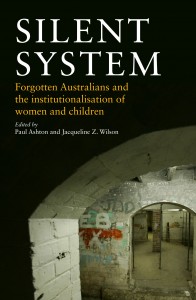
Thursday was a milestone for me, as it was my last official day with the Find & Connect web resource. I was distracted from this sad moment by the Canberra launch of Silent System: Forgotten Australians and the institutionalisation of women and children, edited by Paul Ashton and Jacqueline Z Wilson and published just days ago by Australian Scholarly Publishing. I’m proud to say it contains an article by me, called ‘Tracing the Past: the Find & Connect web resource’, which sits amongst work by Shurlee Swain and Nell Musgrove, Lily Hibberd, Wilson and Ashton, Dolly McKinnon, Tracy Ireland, Denis Byrne, Maria Tumarkin and many other luminaries. The book explores women’s incarceration, sites of conscience, and memory.
As I’ve noted previously on this blog, Silent System came about after a conference last September, that engaged with the Parramatta Female Factory Precinct and the women and children who lived at the site, under government supervision, from 1820 until the last decade of the 20th century. The site has, in stages, contained the Parramatta Female Factory, the Male Orphan School, the Roman Catholic Orphan School and, under various names, the Girls Industrial School. It contains ancient buildings and a lot of hard-lived history, and has been the focus of a ten-year campaign by Bonney Djuric, founder of Parragirls, for public recognition of the critical heritage values of the site and its value as a Site of Conscience.
As it turned out, on the day of the launch the NSW Premier announced that the Parramatta Female Factory Precinct [North Parramatta Heritage Precinct] will be sensitively redeveloped as a cultural heritage precinct. This is a huge achievement for Bonney, and for a number of key groups in the area.
One of the best things about working on the Find & Connect web resource was engaging with committed stakeholders and advocates like Bonney. I’m very much hoping to maintain my involvement, into the future.

